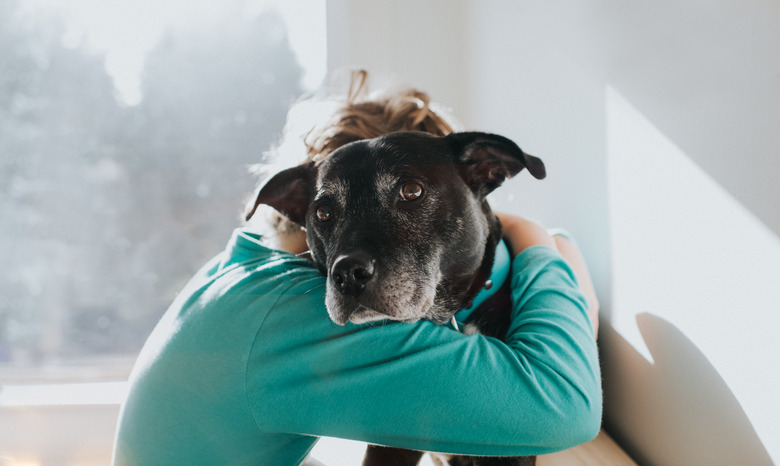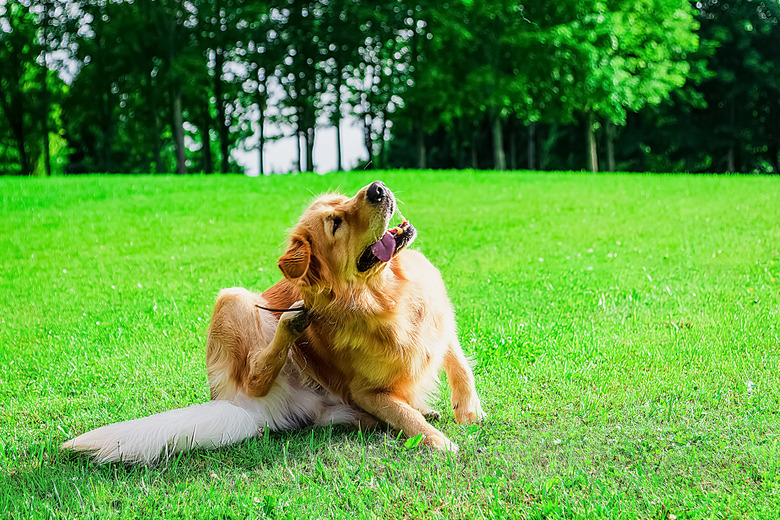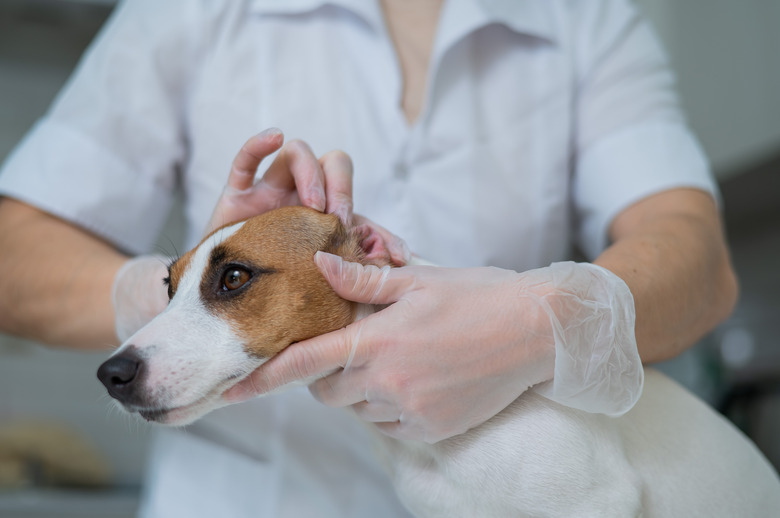Skin Bumps That Are Crusty On Dogs
A cuddle session with your dog can be comforting and relaxing for both of you. However, feeling scabby bumps on a dog while petting them can tip you off to a host of skin conditions that can cause itchiness, discomfort, and infection. Some of the most common reasons for crusty skin bumps on dogs are skin allergies related to their food, to fleas, or to something in the environment.
Causes of scabs on dogs
Causes of scabs on dogs
It can be challenging to determine what is causing crusty scabs on a dog. Never try to treat your dog's scabby skin yourself. You should always take your dog to the veterinarian for a proper diagnosis.
Knowing some of the possible causes of scabs on your dog will help you provide useful information to your veterinarian. Be conscious that allergies can progress beyond scabby bumps on your dog, so watch out for hives or facial swelling around the lips, muzzle, or eyes. These can be early symptoms of an anaphylactic reaction. Severe allergic reactions can be fatal, so call your emergency veterinarian immediately if these symptoms appear.
Seasonal and environmental allergies that cause scabs on dogs
Seasonal and environmental allergies that cause scabs on dogs
Seasonal and environmental allergies are known as atopic dermatitis and can be genetic. Just about everything your dog encounters can be the cause of environmental allergies. Plants used for landscaping or grass in your yard can cause itchy skin reactions that result in scabs. Pollen, mold spores, or even other animals can trigger skin allergies in dogs.
Diagnosis of environmental allergies in dogs can be challenging. You can assist your veterinarian by recording your dog's activities and when you noticed the first symptoms. Your veterinarian may wish to undertake intradermal skin tests and blood analysis to assist with diagnosis.
Scabs on dogs caused by contact allergies within the home
Scabs on dogs caused by contact allergies within the home
Allergies that result in itchy and scabby skin on dogs often pop up when new household cleaning products are used, such as detergents, carpet cleaners, or new pet shampoos. You may see a reaction on your dog's skin when new carpets or furniture are introduced. Dust mites and skin cells from other animals in the home can also cause skin allergies in dogs.
Your veterinarian will want a detailed history of your dog as well as information relating to the use of different household products, soaps, or pet shampoos. Clinical signs and testing will help your veterinarian diagnose contact allergies caused by allergens within the home.
Skin parasites like fleas that cause hot spots on dogs
Skin parasites like fleas that cause hot spots on dogs
Flea allergy dermatitis is one of the most common causes of crusty scabs on a dog's skin. dog owners may not even know they have fleas in the house, as they can be difficult to see. When fleas bite your dog, they inject saliva containing enzymes and histamine-like compounds that can cause an inflammatory response. Sores and scabs may appear when the dog creates a skin irritation by scratching, licking, or chewing.
Look for tiny black spots on your dog's skin, known as flea dirt, that could indicate flea bites. The base of the tail, the underarms, and other parts of your dog's body that are warm and moist can harbor fleas.
Other parasites can cause lumpy and scabby patches on the skin. Demodectic mange, caused by skin mites called Demodex canis, or Demodex injal, the most common type of mange, is not contagious. Sarcoptic mange, caused by scabies mites, is transmissible to other pets and humans. Mange can cause hair loss, skin thickening, and intense itching.
Tick and insect bites can cause scabs. Your veterinarian will take skin scrapings from the affected area and look at your dog's symptoms to diagnose mange. Tick infestation or scabs caused by insect bites will be diagnosed by the veterinarian during an examination.
Crusty skin and scabs caused by dog food allergies
Crusty skin and scabs caused by dog food allergies
Dogs with sensitivities to certain foods may develop itchy skin, particularly on their paws or ears. As the dog licks and chews for relief, the skin becomes irritated, resulting in sores, and scabs. Food intolerance in dogs will often have other symptoms, such as vomiting, diarrhea, or weight loss. Behavioral changes are not uncommon in dogs who are sensitive to certain foods.
To diagnose a food sensitivity, your veterinarian will ask you to conduct a food elimination trial by feeding a hypoallergenic diet containing ingredients that your dog has not experienced in the past. After 12 weeks, you will gradually reintroduce foods your dog is familiar with to help identify which ones cause skin issues and other symptoms. Blood tests can assist in diagnosis, and your veterinarian will discuss these with you.
Pyoderma can cause dog scabs
Pyoderma can cause dog scabs
Pyoderma is a bacterial skin infection. It can cause lesions, bumps, and circular crusts on a dog's skin and is usually found on the chin or abdomen. Some breeds of dogs, especially those with skin folds, are predisposed to this condition. It can also be caused by skin allergies, ongoing exposure to moisture, or unsanitary housing. Parasites, fungal infections, some medications, or hormone imbalances can increase the risk of a dog developing pyoderma.
Your dog's history and presentation will give your veterinarian much of the information they will need to diagnose pyoderma. Additional tests, such as blood tests for endocrinal disorders, may be necessary to identify the underlying cause. Your veterinarian may require skin cytology, cultures and sensitivity tests.
Yeast and fungal infection are common causes of scabs on dogs
Yeast and fungal infection are common causes of scabs on dogs
- Yeast infections. Yeast infections are a type of fungal infection. They can be incredibly itchy, resulting in scabby, crusty skin on dogs. Yeast infections are not contagious and are often the result of a suppressed immune system, but fungal infections can be contagious.
- Allergies and medications. Allergies and immunosuppressant medications can trigger overgrowth of yeast in dogs. Some breeds are genetically predisposed to them.
- Ringworm. Ringworm is a fungal infection in dogs. It is not caused by a worm but gets its name from the raised, ring-shaped mark that can sometimes be seen on infected skin. Ringworm is contagious to other animals and humans through direct contact. Children, older adults, and immunocompromised people are most at risk. Ringworm lesions may develop scabs, although they do not tend to be itchy. Dogs most often contract fungal infections from spores in the soil, but they can also pick them up from other animals or humans.
- Blastomycosis. Other more serious fungal infections can cause scabs, such as Blastomycosis, which can produce round sores that ooze and crust over. This fungal infection invades the entire body, causing fatigue, weakness, loss of appetite, and sometimes blindness. Fungal and yeast infections of the skin are typically diagnosed by examining fungal cultures from skin or hair samples under a microscope. Although with systemic fungal infections like Blastomycosis, other testing may be required.
Treating dog scabs
Treating dog scabs
Crusty bumps and scabs on dogs have such a wide variety of causes that diagnosis by a veterinarian is essential to ensure that treatment will be appropriate and effective. For scabs on the skin caused by allergies and food sensitivities, it may be just a matter of management, keeping the dog away from the things that trigger the problem. Allergy medications and antibiotics for any secondary infections may also be necessary.
For skin reactions to parasites, such as fleas and ticks, your veterinarian will recommend an effective, approved, long-term preventative and advise you on eliminating any infestation in your home. For mites, such as those that cause mange, your dog will be prescribed appropriate oral or topical mite eradication medication. Special baths or dips may also be recommended to soften dry skin and aid healing.
Fungal and yeast infections can require long-term treatment. Your veterinarian will create a treatment plan for your dog depending on the type and extent of the infection, including topical treatments, such as anti-fungal baths. In severe or chronic cases, oral anti-fungal medication and antibiotics to treat any secondary bacterial infections will also be necessary.
The bottom line
The bottom line
Crusty bumps or scabs on a dog's skin can be a symptom of many medical problems that require veterinary attention, some of which are contagious. These include allergies, parasites, and fungal infections. Skin problems can be very difficult to diagnose, and if left untreated, they can lead to more serious complications. Your veterinarian will be able to conduct the appropriate tests to identify the cause and will recommend an effective treatment plan.



